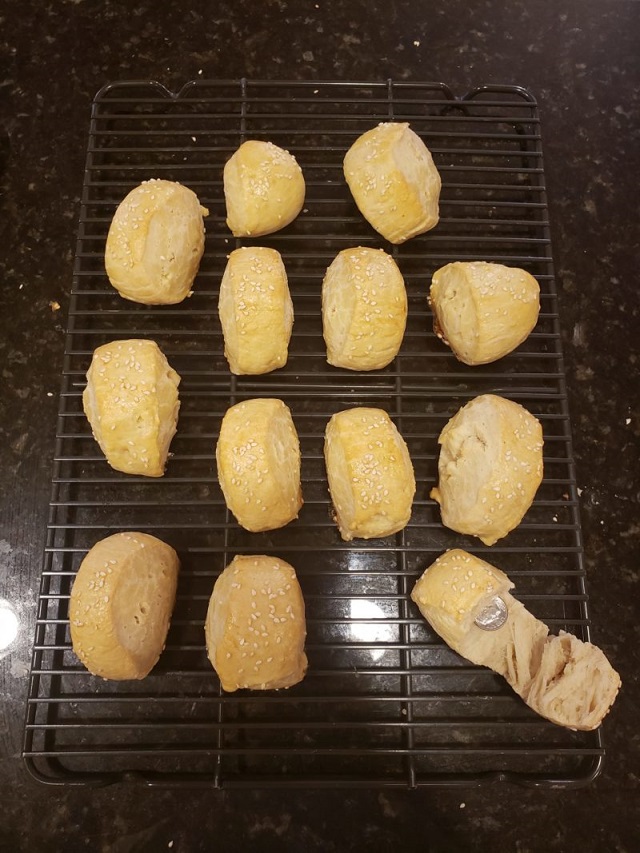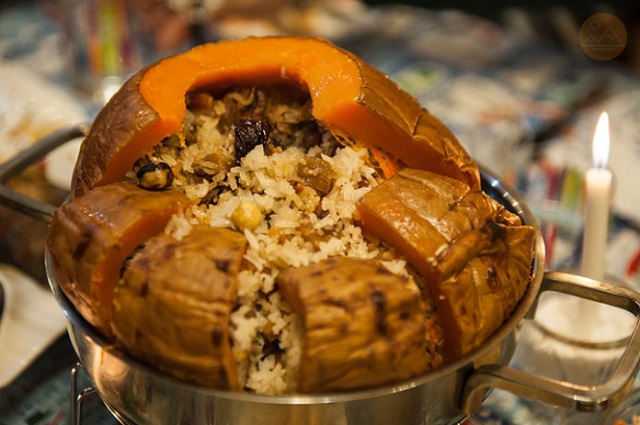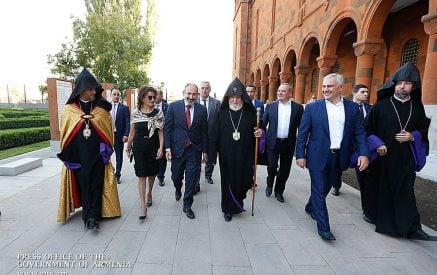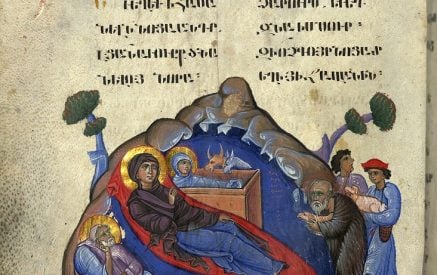DETROIT — This holiday season was a little quieter than many people, especially Armenians, are used to. Due to Covid-19 and the shadow cast by the Artsakh War, the celebrations of the world have been toned down and especially that has been true in Armenia.
Every group of Armenians from every region of the historic homeland or country of the Diaspora has their own traditions and customs and those that relate to Christmas and the New Year are no different. While this survey is not a definitive study, we spoke to Armenians from many different backgrounds, to hear what they had to say about the holiday traditions they grew up with.
Read also
The Armenian Holiday Season
The most salient aspect of the Armenian holiday season is, of course, the celebration of Christmas on January 6. This is why in Armenian it is proper to say “Happy New Year and Merry Christmas” rather than the other way around. In Jerusalem, where the Old Calendar is used, the Armenian Christmas is celebrated on January 19, due the old-calendar year being off by 13 days comparative to the astronomical solar year. The Old (Julian) Calendar continues century by century to deviate, and that is also the reason that some other Orthodox Christians celebrate Christmas on January 7, (and back in the 20th century, on the 6th). For them it is, by calendar, December 25. The Armenian liturgical calendar is the only one in which Christmas is truly celebrated on January 6.
In general, New Year’s Eve in Armenia and the Middle Eastern communities is observed as a day of celebrations, eating and drinking; it is also when gifts are given and when “Gaghant Baba” or “Dzmer Papik” (Santa Claus) makes his visit. It is where the Christmas tree — called in Armenian “Donadzar” (Holiday Tree) makes its appearance. New Year’s Eve in traditional Armenian culture is pretty similar to the secular version of American and Western Christmas.
Armenian Christmas, on the other hand, is for most, a different kind of holiday. Most seem to see it as a special family gathering and meal rather than an over-the-top festival style holiday.
Why do Armenians then celebrate on a different day than literally every other Christian Church? The answer claimed by the Armenian Church is that January 6 was the original Christmas holiday which celebrated the Nativity, the Visit of the Magi, and the Baptism of Christ. The Church of Rome split the holiday in two with the Nativity on December 25 and the Visit of the Magi along with the Baptism on January 6 (known as Epiphany), and the Eastern Churches followed suit, except for the Armenians. In essence, Armenians celebrate Christmas and Epiphany as one holiday. And in case you’re counting, the time period in the Western Church from Christmas to Epiphany is – the 12 days of Christmas.
Armenian New Year’s Traditions
Pagan and medieval Armenian New Year holidays came at a different time of year. It wasn’t until after the adoption of the Roman Calendar for keeping dates (apparently under Catholicos Simeon Yerevantsi in 1774) that Armenians began celebrating January 1 as the New Year, like the Russian and Greek cultures. This day is traditionally called Gaghant from the Latin Kalendae meaning first day of the month.
According to medieval Armenian scholar Anania Shirakatsi, “kaghand” meant the first day of a month and “kaghindos” meant the first day of the year. This word was actually still used by some Armenians in traditional folk songs such as in Marash where they sang:
Avedis, kaghndos,
Hani bizi injir-koz.
“Good news! New Year’s – so where’s our figs and walnuts?” Yes, that is a combination of Armenian, Turkish, and Latin!
Traditionally, New Year’s Eve in Armenian culture was a time for celebrations and gift-giving and it still is. In 19th century Western Armenia, it seems there was only partial knowledge of Gaghant Baba. In the more prosperous areas closely connected with the West, like Arabkir and Kharpert, he was a known figure; in Evereg, outside of Gesaria, he appeared in school programs “just like in the picture,” according to one book. But in many regions, while Gaghant was associated with gift-giving, there was no need for Santa Claus. Armenians seem to have decided that the word “Gaghant” was related to “gakhel” meaning “to hang.”
In many regions, boys would go from house to house across the flat roofs of the Anatolian-style villages, hanging a bag down the chimney or smoke-hole of each house and singing songs in exchange for sweets, fruit, nuts, or monetary gifts. In Palu, usually the boys would hang an apple, into the sides of which the owner of the house was obliged to press coins as a gift.
Sometimes they lowered down a jug of wine either as a gift or for the lady of the house to fill up; in Malatya it was often a bottle for oghi, if it wasn’t a bag for gifts. In Kharpert, the mischievous Armenian children took “gakhel” to a whole new level; they would accost their father as he arrived home from work, lasso him with a rope or belt around the waist and “try to raise him up to the ceiling”; when the father, laughing, had enough of this nonsense he would give in and open the bags of small gifts he had brought home for New Year’s Eve.
The villagers of Western Armenia used to make merry and feast on New Year’s Eve, but there was one problem. According to church traditions, one must fast for seven days before Christmas. Considering Christmas is January 6, New Year’s Eve was the 2nd day of this fast, which just as in the Armenian Lent, required a vegan diet. The crafty Armenian mayrigs found a solution to this dilemma, by loading the table with the most complex and sweet vegan delicacies, topping it off with Anoushabour (Sweet Soup). Anoushabour, which is essentially a wheat or barley porridge with dried fruits, nuts, sugar, and pomegranate seeds, remains the classic Armenian holiday dish.
Gaghant lives on in the Middle East, and in Armenia where it is simply Nor Dari (New Year). One addition that seems to have been introduced in the 20th century is the Christmas tree, known in Armenian as “Donadzar” (Holiday Tree) as it’s part of New Year rather than Christmas.

Sepastatsi pagharch Armenian Christmas/New Year specialty Made by the author. A dime is placed in one roll
Armenian Gaghant in Istanbul involves decorating the Donadzar and putting presents under it. On New Year’s Eve they have a family dinner and feast on turkey, along with mezes such as bastirma, sujukh, cheeses, topik, and yalanchi dolma. The oghi of course is not far away. At midnight they bring out the dessert tables of fruits and sweets of which the centerpiece is the Anoushabour. At the same time, a relative dressed as Gaghant Baba appears and gives presents to the children.
New Year’s Eve in the Armenian Quarter of Jerusalem is celebrated, according to the Old Calendar, on January 13 — what the Russians and inhabitants of Armenia call “Old New Year.” On December 31, as the rest of the world celebrates New Year’s Eve, the local Jerusalem Armenians might host a barahantes or young people might simply go out on the town as in other countries. (As a side note, “Western Christmas” on December 24-25 is also observed in Jerusalem by the Armenian Catholic community, and the Apostolic Armenians attend their organized festivities in a spirit of brotherhood.)
But on January 13, the Rum (Byzantine) Orthodox and the Armenians of Jerusalem celebrate New Year’s Eve according to the Old Calendar. Everyone wakes up in the morning, and Scouts and cultural clubs invite the Gaghant Baba to distribute gifts to all the children of the community. In the evening, groups of family friends come together. The Anoushabour is served along with Dalakh (lamb spleen stuffed with parsley and garlic) and Chi Kufta. At midnight the big bell of St. James rings and the whole community of the Armenian quarter puts on their coats and goes to the middle of the convent. The students of Tarkmanchats do recitations and singing in front of the brotherhood before everyone goes their way.
In Beirut, New Year’s Eve on December 31 is a special occasion for the Armenian community. Just as in other parts of the region, the holiday tree is decorated and referred to as Gaghanti Dzar (New Year’s Tree). According to Shoghig Tcholakian Terjimanian, it was a tradition in her family that you had to sing joyously while decorating the tree. She shared a song she learned in school in Beirut:
Gaghant e aysor
Amanor dari
Tzayne ge lsvin
Yerki oo bari
Mrs. Terjimanian has also taught this song to her children who were born in the US.
Back in Beirut, the New Year’s Eve table was abundant with tabbouleh, basterma, plaki, leblebou and other delicacies. At midnight, in anticipation of Santa’s arrival, the children sing the Gaghant Baba Yegav song. After Gaghant Baba knocks on the door and is let in, he distributes gifts and the children eat sweets until the wee hours of the morning.
The Armenian village of Anjar, Lebanon, is one of the most historic Western Armenian communities, being settled by the refugees of Musa Dagh in Cilician Armenia. According to Hermine Der Vartanian, Gaghant Baba arrives on New Year’s Eve, but doesn’t bring presents, as the children have already received presents from their parents. Instead he asks the children if they’ve been good and perhaps they will sing a song or do a recitation for him. The famous holiday treats for New Year and Christmas are “gatov kekhke” (similar to cheoreg), “tzetov kekhke” (more like bread) and bourma. The inhabitants of rural Anjar are known to fire off guns into the air to celebrate the coming of the New Year at midnight.
Armenians in Iran also are sure to put up their Donadzar in time for New Year’s Eve. Generally there are parties thrown by the local churches or community centers. Persian-Armenians wake up on New Year’s morning to find presents under the tree left by Gaghant Baba, also referred to as “Dzmer Papik” (Grandfather Winter, the Soviet Armenian version of Santa Claus). The traditional gift that comes from him is “mirk.” While in Armenia proper that word just means fruit, in Persian Armenian culture (as well as in historic Western Armenia) it refers to a mixture of dried fruits, nuts, chickpeas, etc. One gets presents on New Year’s Day so that one starts the year with new things.
New Year’s Eve in the villages of Armenia today generally involves slaughtering a pig, drinking a lot of homemade oghi and setting off fireworks. This year, things were more somber as the whole country is in mourning for those who gave their lives in the Artsakh war. The celebrations did not take place for the most part just as the giant tree in downtown Yerevan was not set up.
Folklore expert and Armenian teacher at the AGBU School in Southfield, Anahit Toumajan, grew up in the village of Meghrashen near Gyumri. As she tells it, New Year’s Eve in Armenia was the most special time of the year.
Toumajan said the entire house would be cleaned, all the beds would be changed, clothes would be washed, and everyone would get new clothes if they needed it.
Anyone who had a disagreement with anyone else in the village had to make up by New Year, often by inviting their rival to their home for a New Year’s Eve feast. The doors of all homes were open from New Year to Old New Year (January 13).
The New Year’s Eve dinner consisted of goose, turkey, or a couple of chickens. They had homemade oghi (locally made from apples) along with the Ararat Cognac. The family would sing songs like Seghann Eh Arad (“The Table Is Bountiful”). There was chocolate and seven types of dried fruits or sweets on the table – just as in 19th century Western Armenia, for example in Palu, there were seven foods that would be eaten on New Year’s Eve (all vegan, and often involving dried fruit).
An important part of the New Year in Meghrashen was the large round Glor Gata bread which was literally called dari or year and was baked in the tonir (sunken pit oven found in traditional Armenian homes across historical Armenia). It was round symbolizing the completion of the circle of the year and was a typical Eastern Armenian style Gata with khoriz. A coin would be baked into it. Toumajan states that her ancestors came to the Gyumri region from Kars at the beginning of the 19th century. It is well known that the region was settled by migrants from Kars and Erzurum (Garin).
In the village, they did have a visit from Dzmer Papik, but it was, as with many other communities, in the context only of the year-end school recital, where Dzmer Papik would appear with his girl fairy assistant and distribute books as gifts to the top students and sweets, raisins, or nuts to everyone else.
Traditions Change In The New World
The Armenian-American community has heartily embraced the American Christmas in many ways. Now-retired Fr. Yeprem Kelegian for many years led the St. Mesrob-Racine ACYOA to the sick, elderly, and shut-ins of the close-knit Wisconsin Armenian community, to sing them Christmas carols including the Armenian hymn Khorhoort Medz.
Many other Armenian communities across the country have similar initiatives.
Sometimes Armenian and American customs were melded. Marianne Dardarian of West Bloomfield MI recalls, “As kids (in 1960s Detroit), grandma always made a rib roast on Christmas Eve and Kharpert kufta on Christmas Day along with ham or turkey.”
Dardarian continues to prepare Kharpert kufta for her extended family on Christmas Day, this year dropping off packages at family members’ homes, due to social distancing.
Since the family celebrations have largely moved to one of the two Christmases, New Year’s Eve in the Armenian-American community has largely — and for many years now — become an occasion for dinner-dances (kef, hantes, barahantes, khunjouyk). Churches and organizations across the country have hosted them for years. The famous, lately discontinued PAND (Philadelphia Armenian Nor Dari), was a rare unified community event which used to split its proceeds equally between the 5 Armenian churches of the area. Hagop Asadourian’s Armenian novel Hovagimi Tornortiner (The Great-Grandchildren of Joachim), which revolved around Armenian-American life, had an annual unnamed organizational New Year’s Eve dance as one of its central themes.
That being said, many families, especially those who have come to the US in recent years from Armenia, continue family celebrations on New Year’s. One source who was born in the states to parents from Aleppo said the family would have a big Armenian feast on New Year’s.
“My aunt would make madzoonov kufta and put an olive in one of the kuftas,” an alternative to the traditional coin into some type of bread.
Yerchanig Callan, who grew up in Detroit, said that her Yozgatsi-Gesaratsi family always ate lamb brain on New Year’s Eve “so they would think good and intelligent thoughts in the New Year” and lamb tongue on New Year’s Day “so they would speak well through the year.”
For many of those who have come more recently from Armenia, celebrating on New Year’s is indispensable. “New Year’s is the biggest holiday,” our source tells us. “Every single year we set up a big table with all our best Armenian food,” listing off oven-baked pork, cabbage (vegetarian with beans) and grape leaf (meat) dolma, salads, lots of sweets, and the famous Gata, not forgetting Champagne.
Friends call to wish each other “amenalav baner” (all the best things) for the New Year. On New Year’s Day, there is an all day dinner which includes Gata. Formerly, they would bake a coin into the Gata and whoever got the coin would have good luck for the year; lately due to sanitary reasons, the family has begun replacing this by putting a chickpea into one of the ichli kuftas. The celebrations continue, though to a lesser extent, until Old New Year on January 14.
Armenian Christmas Traditions
Hayganush Paylan of Illinois, a daughter of Genocide survivors who was raised in a family that remained in the town of Malatya in Eastern Anatolia until the 1970s, related some interesting traditions.
The family was just trying to put food on the table and survive, she tells us. Whatever the Armenians did in Malatya before the Genocide, she is unsure. But they tried as hard as they could to keep traditions alive afterward. New Year’s Eve was a time for eating nuts, oranges, and special fruit that they didn’t eat at other times. They would keep a watermelon fresh by burying it in the sawdust that they used to burn in their stove instead of wood, and they would eat that watermelon on New Year’s Eve.
Paylan’s description of Armenian Christmas had a lot in common with Toumajan’s description of an Armenian village New Year in the Soviet era. Paylan also explained that the whole house would be cleaned in preparation for Armenian Christmas. Paylan’s mother had memorized all the holidays and fasting days of the church calendar. She would clean the entire house and put out special doilies and all white linens and drapes only for Christmas and Easter. Then, she would fast for 2 days before Christmas, not doing any housework, while spiritually and mentally preparing herself. Then on January 5, Armenian Christmas Eve, they would light candles and pray.
On Armenian Christmas, everyone would have something new to wear. After breakfast they would get “dolled up,” and then people started to visit. The family would go to at least 7 households, usually of elderly people or relatives. Everyone would kiss the hands of their elders.
Paylan explained that when they kissed the elderly’s hand, the person kissed them on the head, and also gave the young person coins or sometimes candy. One cousin would even give jewelry. Meanwhile, when they returned to their own home, they had to be prepared for visits as well. Ghurabia, baklava, and soorj (coffee) would be served to the visitors. Paylan, as the youngest daughter, had the job of spraying the hands of anyone entering the home, with lemon cologne.
Some Turks would also visit the family in honor of their holidays.
In addition to the leblebi, oranges, dried apricots, dried pears, apples, raisins and walnuts, holiday foods included lamb or chicken stuffed with pilaf, and a special dish called Ayva Abour (“Quince Soup”).
Meanwhile, in Istanbul some other very traditional Armenian Christmas customs were celebrated. Up until the 1970s, the traditional Armenian caroling still took place in the Armenian neighborhoods of Bolis. After the jrakalouyts service, young people go around the neighborhood with colored paper lanterns and sing the carol Melkon, Kaspar, yev Baghdasar (the names of the Three Wise Men) from door to door. They would receive sweets at the houses that they visited.
Typically a meal of grilled fish with onions and roasted potatoes was eaten, often palamut, a popular fish in Istanbul. They also had topik and yalanchi dolma, which were indispensable on Christmas Eve, along with beoregs. The next day, after Church, relatives and friends would visit each other from house to house, and the visitors would be offered chocolate, khadayif, gatnabour, and homemade fruit liqueur.
In Beirut in the 1950s-1970s, Terjimanian adds, Christmas was doubly meaningful for her family as it was her father Avedis’ name day. On Christmas Eve many friends and family came to congratulate Avedis on his name day. A mezze and sweets table would be laid out. Terjimanian recalls that as she was a student at the Vahan Tekeyan School, one year her class of 6th grade schoolgirls went on a minibus from house to house to visit certain people the teachers knew and sing Khorhoort Medz. The people would open the door; some would let them in, some would bring candy and chocolate to pass around. They would also give a gift to the teacher – that is, a monetary gift to the school.
Similarly, the Protestant Armenians would organize a group of carolers at midnight.
On Christmas morning in Beirut, Terjimanian remembers, they would start singing Khorhoort Medz at 7 a.m. as their father Avedis awoke. He would then give each child a coin and they would all go to church; after church, friends would come and visit to congratulate Avedis on his name day.
On Christmas Day, because Terjimanian’s family was Kessabtsi, they would eat herissa, along with ganach fasoulya, beoreg, and so on.
My sources from both Beirut and Anjar spoke about lighting candles, burning incense, and praying on Armenian Christmas. For some of these families, the tradition of burning incense on Armenian Christmas Eve is also continued in the United States, including incensing outside the house, reminiscent of the old Armenian way of thinking where everything including the outdoors and the farm animals should be blessed.
Der Vartanian, from Anjar, remembered making Soorki cheese and eating it on Christmas along with different types of fruits and chestnuts.
Armenian Christmas in Jerusalem is celebrated according to the Old Calendar on January 19. On the morning of Christmas Eve, the 18th, there is a special procession of the Armenian Patriarch from Jerusalem to Bethlehem, escorted by the scouts, with drums, trumpets, and bagpipes. There is a special convoy so that all the roads are shut from the Old City to Bethlehem. Arab Christian scouts are also invited to partake, as they had invited the Armenian scouts to participate in their Christmas Eve procession on January 6 (again according to the Old Calendar). The Palestinians of Bethlehem have placed a huge Christmas tree and life-sized manger scene in front of the Church of the Nativity since December 24. When the Armenians arrive in Bethlehem, it is one service after another, including all the liturgical sharagans for Christmas. People are there from midnight to the next morning. At midnight, the Armenian Patriarch goes outside to the manger scene where he gives a message to the Palestinian president, his people, and the local Armenians. Finally the Armenians return to Jerusalem where badarak for Christmas Day (January 19) takes place at St. James Cathedral. That evening, rather than a familial gathering as on New Year’s, the Hoyetchmen group has a kef night at the local Ramgavar agoump.
One of the most interesting traditions of Armenian Christmas was told by a Persian-Armenian source who came to the US in her teenage years. Whether in Iran or here, families gather for a special meal on Armenian Christmas, January 6. Fish is always the main course. Another staple is Kuku, which is like a frittata with many greens in it. Perhaps the most interesting was the custom of pouring everyone a glass of wine and taking a nshkhar (unconsecrated Communion bread) and breaking off pieces of it which are thrown into each wine glass. When the family members are done drinking their wine they eat the nshkhar bread. “We used to try to drink that wine so quickly, so we could get to that holy bread, that was the best part,” our source tells us. In this particular family, music and culture was valued. “Anytime we had gatherings for the holidays, once we eat, we get up one by one and sing a song.” Regardless of each family member’s ability, they were expected to perform for the rest of the family. These traditions have also been continued in the US by several Persian-Armenian families we contacted.
Toumajan related that Armenian Christmas was downplayed during the Soviet era. However, since her grandmother had been a Der Hayr’s daughter, and her grandfather had wanted to be a Der Hayr himself before the Soviets clamped down on religion, Christmas was celebrated in their home in the village of Meghrashen. There was always fish on the table, she tells us, and something similar to anoushabour. A special meal they ate on Armenian Christmas was Keshkeg, which is a variation of Herissa, using whole grains and big pieces of lamb.
Another Armenian family who immigrated from Yerevan in more recent years, says while New Year’s Eve is a big celebration with friends and distant relatives, Armenian Christmas is “only family.” The main course is fish, boiled with potato and spices (often rainbow trout). Some kind of dish consisting of scrambled eggs with spinach and greens, similar to the Persian-Armenian Kuku, is also on the table, as well as Zadigi Plav which is also eaten on Easter (many Armenians refer to Easter as Medz Zadig and Christmas as Pokr Zadig) and consists of white rice with raisins and an egg crust. All of this, the family is continuing to do in the US.
The older generations of Armenian-Americans have also preserved some of their customs from Western Armenia. Though for most of them, Armenian Christmas has become a solely religious holiday on which to attend church and drink blessed water from the services of the day, we were able to collect some information on Christmas traditions. Dardarian said that in 1960s Detroit they would have specialties like anoushabour, sou beoreg, and “paghaj” (pagharch), on Armenian Christmas. This latter baked good, which are prepared as individual rolls, was a specialty bread of the people of Sepastia, and Dardarian’s mother would bake a coin into one of the paghajes. (In Old Sepastia, this custom took place on New Year’s).
Susie Reizian, also of Detroit, recalls the coin tradition being done with cheoreg on New Year’s Day, and that multiple denominations of money would be placed in the cheoregs, with those getting the larger coins supposedly getting more luck. Relatives would often “cheat” out of love — Mrs. Reizian recalls her grandmother turning the plate so that the luckier cheoreg would end up pointed toward her and her sister; Dardarian recalls that her uncle would go around and stick dimes into everyone’s paghaj so that they would all be lucky. In other twist, Diane Kachadurian Nolff recalls unwrapping the figures in the nativity scene and that whoever found the Baby Jesus would similarly have good luck for the year.
Yerchanig Callan said in 1950s-1960s Detroit, her parents would take her and her brother on Armenian Christmas to visit their grandparents; one set were natives of Yozgat and the other couple were from Gesaria. The children would hold a candle with a ribbon in their left hand, then take the right hand of the grandparent and kiss it, handing them the candle and saying the Christmas greeting. The grandparent would kiss the child on the eyes. Mrs. Callan remembers eating rojig (walnut and grape rolls) and ghapama (stuffed pumpkin, which her Gesaratsi grandmother made) on Armenian Christmas. She fondly recalls helping her grandparents prepare these dishes. “Years went by, and suddenly I was making ghapama again. And I can say that my grandkids really like it!! Resurrected tradition. Do you think hand kissing can be far behind?”
Karinne Andonian, a young mother from Philadelphia, shared that her family traditions, mostly stemming from Malatyatsi ancestors who came to the US some 100 years ago, include making copious amounts of Hrishdig (a version of Sujukh), Cheoreg, and Tourshi. Her grandfather’s side of the family, which also hails from Malatya, but via Baghdad, introduced a type of kufta soup called Kubba Hamid. She gifts a pomegranate on New Year’s Day to some of her closest friends; her grandmother on her mom’s side always ate pomegranates at this time of year because her father (who was from Arabkir) would buy her a pomegranate around New Year’s or Christmas. Although it is difficult to keep all these specific holidays and specific traditions on the exact day or in the exact same manner as previous generations due to the stresses and busy schedules of American life, Andonian says she feels “the opportunity to take a bit of the old and adapt it to the new so our children can feel the spirit of it.”
As different as the backgrounds, origins, and journeys of different Armenian families are, they all share similar joyful holiday traditions. One’s family may eat fish, kuku, and gata; or turkey, kufta, and pagharch; sing Khorhoort Medz, Melkon-Kaspar, Gaghant e Aysor, or Silent Night, but the memorable Armenian holiday traditions are always about recognizing a special time to be with loved ones to open a new chapter of life out of the darkness of the winter. We need to remember that this year more than ever.





























































